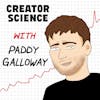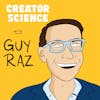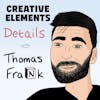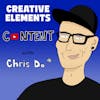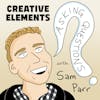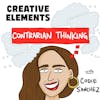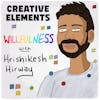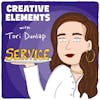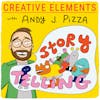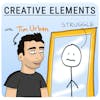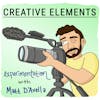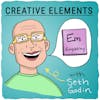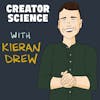
Kieran Drew is a former dentist turned copywriter who launched a course called High Impact Writing.
Kieran Drew is an ex-dentist who quit dentistry to learn writing, and now that is what he is teaching others as well.
Kieran has a newsletter called Digital Freedom with nearly 30,000 subscribers.
He also has more than 175,000 followers on Twitter, which is potentially where you have heard of Kieran. And recently, Kieran launched a new course called High Impact Writing.
In this episode, you’ll learn:
- The process for creating and launching this course
- What he would do differently if he were to do it again
- And all of the other lessons that he learned in launching High Impact Writing
Full transcript and show notes
Follow Kieran on Twitter / Newsletter / LinkedIn
Kieran's Course
***
CONNECT
🙏 Make a guest or mailbag request
📝 Check out our curated Playlists
***
SPONSORS
💼 View all sponsors and offers
***
SAY THANKS
💜 Leave a review on Apple Podcasts
Learn more about your ad choices. Visit megaphone.fm/adchoices
Jay Clouse [00:00:07]:
Hello, my friend. Welcome back to another
Jay Clouse [00:00:14]:
episode of Creatorscience. We have a fun new episode here for you. Today, I'm speaking with my friend Kieran Drew. Kieran has a newsletter called Digital Freedom. with nearly 30,000 subscribers. He also has more than a 175,000 followers on Twitter, which is potentially where you have heard of Kieran. Kieran is an ex dentist who quit dentistry to learn writing, and now that is what he is teaching others as well. And recently, Kieran launched a new course called High M packed writing. I had a front row seat to that course launch on Twitter and from his newsletter. And boy, oh, boy, did it go well. I will let him tell you just how well that course launch went. The launch was
Kieran Drew [00:00:57]:
4 days long. There are 500 students give or take maybe, like, 3 or 4 people, and we made a a $142,000. I can't remember the exact to the dollar, but it was around there. 4 days,
Jay Clouse [00:01:11]:
500 students, a $142,000 at the launch of that course. Now to be honest with you, I've never had a launch anywhere near that successful. And so I wanna learn from Karen just as much as I wanted to share with you what he learned in this process. So in this episode, we are getting into the weeds. We are talking all about the process for creating and launching this course. We talk about what he would do differently if he were to do it again, and all of the other lessons that he learned in launching high impact writing. love to hear your thoughts on this episode. As you listen, you can find me on Twitter or Instagram at jclouse. I'm getting more active on Instagram. So find me over there if you have already. Just tag me, say hello, let me know that you're listening, and now let's talk with Kieran.
Kieran Drew [00:01:59]:
In terms of the price point, we launched the main course at 297. couple days before we added tiered pricing. You know, I'm a huge fan of Nathan Barry. I know you are too, and I I just remember him saying it a while ago, and I was like, You're missing something here. So I added that on which was a thousand bucks. And what that was was just the course and a call with me. That gross may be an extra 10 k. And then what we did was I released my first product a year ago, total 12 months before this one. So that was an upsell, you know, one click offer sort of thing, and and that gross maybe another 8000 or so. So, you know, small touches around it, but kinda adds up over time. Yeah. So retail price was 2.50. And so the upsell was basically, you know, this is a one time offer. You can get it for, whatever, 63% off, which was around $98,
Jay Clouse [00:02:50]:
I think. I'm already loving this so much because people don't talk about this, and I love geeking out about I love this type of thing. Like, really breaking down exactly what's going on here. We do this type of thing in the lab all the time, but it's fun to do this in in a public forum. So this is the 2nd product launch. How would you compare it to your experience with that first product launch, the the original $250 course?
Kieran Drew [00:03:12]:
How would I compare it? I mean, it's like it's kinda like going to, like, kid soccer game for number 1 versus, like, a proper professional match. it was absolutely wild. I mean, the the first product was I had I had no clue what I was doing. And, I mean, I still have no clue what I'm doing. But A little bit further along that cleanlinessness. But, I mean, the first one was 5 k in 5 days. And, yeah, just this one was completely unexpected in terms of how it went, particularly on the last day, which was I think it was, like, 75 k on the final day alone. Really? Yeah. Yeah. I mean, to be to be honest, mate. Like, I'll tell you a quick story. So I try not to get my hopes up about these things, but I had started speaking to entrepreneurs who were like, you know, Twitter creators, it should be getting 6 figure launches. And I was aiming for 30 k this time around. And there's just people like Grand AirP, and I kinda got my hopes up a little bit, which is like my rule number one for crying. And anyway, so when I click launch, you know, send that email the second time around, I was like, Don't get your hopes up, but, you know, we're gonna go to the pub in 2 hours, me and my girlfriend, and celebrate this influx of sales. And I think we made 8 sales in the first two and a half hours. And I could just watch and and I work pretty hard for this one. I could just watch 3 months of effort, like, because, like, something is seriously wrong in my funnel somewhere. Like, maybe I got, like, a spelling mistake at the start of the copy. But I think this social proof flywheel really started to kick in around day 2, day 3. to the final day, man. When I woke up the financial hours of the launch, I
Jay Clouse [00:04:44]:
mind blowing. And for context for folks, you're you're saying Twitter creators, you have about a 168,000 followers on Twitter at the time of writing this. Email list is how big? 2022,000.
Jay Clouse [00:04:56]:
22,000.
Jay Clouse [00:04:57]:
So significant on both fronts, do you have any idea, like, attribution
Kieran Drew [00:05:03]:
percentage that came from email versus Twitter? You're gonna hate me, man. I don't. I wish I could. Yeah. Like, I'm sure there is a way to do it, but usually my rule is I just don't sell on Twitter. so that I know precisely what's going on through email, and I can just treat it to it as top of funnel. But flagship product, I thought this time Let's just build hype around it on social. And so I I can't actually track what what it is. You've been you've been using the word we a lot.
Jay Clouse [00:05:28]:
is in we did this. We did a 4 day course this time. Is is there an actual we, or are you just using the royal we to refer to, like, the company? I'm British shows the royal we. I'm really good at me.
Kieran Drew [00:05:41]:
Me and my girlfriend. So my girlfriend, actually, she became a partner in the business in in January. So she quit at 9 to 5 because, like, she's crazy busy. And so she handled all the design stuff, very helpful in, like, operations because I organization skills are awful. So, yeah, it was a it was a very, very big joint effort this time, Ron, which is brilliant.
Jay Clouse [00:06:00]:
How long did you prep for this? Like, I wanna talk about what led up to the launch. You know? You said that the launch was 4 days. I wanna get a sense for what led up to that 4 day period that allowed those 4 days to be such a success. I'm not a launch expert at all. Obviously, it's second launch I've done, but it did go really well. And I think the thing that helped the most, mate, was
Kieran Drew [00:06:21]:
It wasn't, you know, 2 weeks before, but maybe even the entire year before because one thing that I prioritized with my brand is that have been trying to overdeliver every opportunity. So we've created 8 free video courses. And I feel like that free content almost proved our credibility in terms of you know, this guy's worth investing in because people only buy, right, when when they have a problem to solve and when they trust you. And so I feel like that trust was the long game. We have been built quite a nice brand over time. In terms of the actual product, so I started advertising it in in in January. So it's about 4, 5 months before. I hadn't built it. I didn't know the name. I'm just a very big fan of public accountability. to start talking about something to make it happen. But what happened, Jane, I think you actually wrote about this about con consistency being a gift and a guess. Right? I have very rarely not posted 2 threads a week and my newsletter. And what happened, mate, was, like, after about 2 months, high impact writing still didn't have a name. Still hadn't been written. And so around February, May time March time, it was all in. So I stopped writing Twitter content. I just repurpose old stuff. I actually stopped my whole newsletter. And that was terrifying, ma'am, because that was the first time I tried to make, like, an asymmetrical bat. as opposed to that, like, consistent grind fest. So the real work put aside about 33 to 1 months prior.
Jay Clouse [00:07:45]:
And that looked like actually writing the course, filming the course?
Kieran Drew [00:07:49]:
Yeah. So in terms of building the course, I originally wrote it straight onto slides as in, you know, this is how it's gonna look, and it just came out so waffly. Like, it just wasn't concise enough. I tried to skipped that writing stage, which is so stupid for me because, you know, writing is the core of everything. So I had to throw it away. I ended up rewriting it maybe, like, three, four times. And by the end of it, mate, you know, I wrote it on computer, stone too waffly, I thought, you know what? Let's write it out by hand because that really forces you to be concise. Wow. then we turned it into slides, which my girlfriend did create designing. Because what I was trying to do, man, was have this, like, moment every 5, 10 minutes. And quite a lot of that is the delivery, you know, these, like I call them sexy final sentences, which we can just really summarize your points. So The writing bit was probably the bulk of it, and then there was the whole marketing around it afterwards.
Jay Clouse [00:08:40]:
Yeah. I I've gotten this flow now where if I'm creating something that's going to live on slides, my my flow is I basically write it out in bullet point format in a page. And this is true for presentations. It's also true for the courses I make. Like, for courses, I I go into Notion. I make a table database, and then I start just, like, dropping all the ideas I have in terms of, learning objectives or questions. Sometimes they're kind of one of the same. So, like, for the community building course I had, it's, like, launching with email, launching with Twitter, pricing your your membership. And then I'll order those things. And then each of those line items in the Notion database can be opened up into a page, and that's why I do, the bullet point structure, those become slides, and that becomes recorded. But there's a lot of steps in there. Like, the actual, like, writing and formatting, of courses. And I learned a ton from LinkedIn when I worked with them at LinkedIn Learning. They acquired linda.com a few years ago. That's what LinkedIn learning where it came from. And I learned a ton about them in terms of structuring learning content around learning objectives for each video. They were very strict. Like, every video lesson should have its own discrete learning objective that you can phrase as by the end of this video, the course the student will be able to, and then it's, like, verb. There's, like, this thing called bloom's taxonomy, verbs. And it's stuff that's, like, 6 different columns, knowledge, understand, apply, analyze, evaluate, create.
Kieran Drew [00:10:14]:
And they they said, you should be able to pick one word from each of these columns.
Jay Clouse [00:10:18]:
By the end of this lesson, the student should be able to solve this type of problem or relate this type of thing to this type of thing or defend this type of thing. So it's it's really interesting. How did you even go on learning objectives? How did you think about that in what became
Kieran Drew [00:10:35]:
a lesson versus a module? How did you go about structure? Yeah. I mean, I think I might have heard you talk about this before. So there is back in my head that every slide every lesson has to have a the student gets this benefit from the thing, and you kind of extrapolate that upwards. Right? So it's per lesson, per module, per course. the thing that I struggled with a lot was what stays in and what goes out. Mhmm. And when I wrote the the final draft, I actually ended up deleting maybe another 30, 48%, and that was quite brutal, but it was like no. It's all actually just bonuses now. Right? Or it's coming, like, bonuses stuff I wanted to put in. But but for the most part, mate, I thought about so for each lesson, it either had to dispel a big myth or hit home, you know, a firm belief of mine. So the big myth was always a great positioning because it was always like most people tell you to write platitudes to grow But, actually, if you look at my story to eat format, storytelling will get 5 times the amount of impression to profile visit ratio, So here's how you write a story to me, and then we dive into it. And the feedback has been brilliant on that side of things where people are like I feel like you're opening my eyes on stuff. But I do have a little bone to pick with you, mate, because one thing I love about you is your commitment to quality. I think it really shines through, and My first product was just scrappy, put together, no planning, all this sort of stuff. And so this time around, obviously, a lot of work going into it, and I sent you a message about 6 weeks before being like, hey, man, you sound great. Like, what what what what mic are you using? So you sent me the mic. What I didn't realize about these mic so that they have to be quite close to your mouth. Oh, yeah. And so I've filmed 64 lessons, and Audio is too quiet. Yeah. But you can boost that. You can fix that. It's all get it's all getting sorted now for the relaunch. But I was just like, I got one email, and then, you know, one of my favorite rumors about the Internet is, like, if one customer is saying it, 10 customers are thinking it. And I don't know why I didn't just listen to it myself on, like, Tier 3.
Jay Clouse [00:12:40]:
So thank you for that, mate. But I do sound nice. I just need to crank it up a little bit. Yeah. I mean, also, like, hire an audio engineer People ask me all the time, like, what microphone do you use? It sounds so good on the podcast. I'm like, well, I'll tell you the microphone. It's a road podcaster USB microphone, which you have right here, which I don't even know they still made. It's great because of the audio profile that comes through, but what people don't realize is this audio is also mix by an audio engineer who's fantastic. Like, not only does the microphone give good raw material, he makes it really, really great. And an audio engineer could take that and make it louder. Be easy for them to do. Thankfully, one of my customers is an audio engineer, so he's very kindly So I wanted to sort it all out for me. After a quick break, Kieran and I dig into what he said a moment ago, which was during the creation of his course, He stopped creating new social content and repurpose some of his old content. We're gonna dig into just exactly how he did that right after this. And now back to my conversation with Karen Drew. You mentioned a second ago that when you're really in the trenches of building the course, writing the course, you didn't write on Twitter, you just repurpose things. Seems like people who get in a point where they're They wanna focus on some bigger project, but they feel like, but I have some momentum. I don't wanna lose momentum. I wanna do this. So when you did that, talk to me about your process for repurposing your Twitter content for a couple of months. What does that look like? So, actually,
Kieran Drew [00:14:07]:
on my notion, I have something called a Hall of Fame. Basically, when a tweet hits its own criteria, it gets imported into Notion. So I have this database of, you know, 100, probably about a 1000 tweets now. So the actual repurposing bit was pretty straightforward. I personally don't like to just repost stuff. And if I am gonna do that, it has to be 6 months minimum. know a lot of people say 3 to 4, but I can tell when someone is reposting their stuff every 2 to 3 months, and I I I did think that, like, reputation is something you should prioritize. But what I will do, mate, is I'll take 1, 3, and I'll turn it into 10. Very, very similar. And then, you know, is it like a sniper than a shotgun. Right? So you have one 3 day at home and then you spread the effect. So done that. just I I set aside maybe 5 hours and I just went through my wallet fame and I just turned it into loads more stuff. And then I took my threads and I just changed the hook. You know, different angle, storytelling angles. If it was already a storytelling angle, turn it into just a, you know, create a tips angle. Just stuff like that, man, because I'm very conscious that this whole content game becomes a bit of a trap. Right? And there is actually a lot more that you should be doing with the leverage you build down the line. But if you're constantly in that that corridor content, you just can't do it. So I want a a big push to try and make content as effortless as possible. Because at the end of the day, man, like, the product only went so well because I put so much time into it. But by doing that, it's helped me kind of step up that next level. You know? I sort of clawed my way from, like, having no criminals and dentists and didn't even know what copyright existed. So it kinda just it just goes to show that sometimes it's better to step away, make content as effortless as possible so you can go big on something else hopefully boost your authority and reputation after? For your hall of fame, is that an automation that runs through Zapier or something? Can you walk us through how that functions? Yeah. So originally, it was through make, fully automated. So I I didn't build this, by the way, a friend did. And when a 2 equal to 300 likes, it would auto import. I do love data driven growth, but, like, even way too into particularly for social. And to me, I just say, like, likes. It's not the perfect metric, but at least it's a good indicator of, like, people enjoying it. And it would just auto import every day anything they got above 300. The problem is now that that API change happened, it really screwed up the whole plan. So what we're doing now is blackmagic emails our report. Right? And I think you can download that report as a c Excel file, and then the rest happens automatically. So I actually don't have that running at the moment. He's just building it for us now. Yeah.
Jay Clouse [00:16:47]:
Well, give me his email. I actually think I I actually think that you can work around that make thing by making your own personal Twitter app. I mean, I had a similar thing happen with, like, tweet 100 was a project I did. That's completely dead now because of this Twitter thing. I was doing a similar automation, but it was logging every tweet and tabulating the results of that tweet after 24 hours, and then I would rank by activity. But I also haven't solved the problem since it was broken. So when you when you did that 5 hour session, are you then scheduling
Kieran Drew [00:17:19]:
those tweets in some other third party software for a week at a time, a month out of time. Yeah. I mean, I schedule in home fury. So, I mean, at that time, I scheduled as far ahead as possible, which was a good couple months, and it's probably it's probably maybe more like 6 to 8 hours when I went back to edit it the next day. But I'm always may I'm a week to 2 weeks out of contact? So everything is scheduled because I for 1, I hate that feeling of pressure. Right? If I ever have to sit down and think, oh god. I have to do something today, kind of snaps me out of the flow of executing on high level of contribution. But also, man, I think it's a really cool writing trick. Right? If you could just get a couple weeks ahead, then on a Monday morning for 20 minutes, you know, I'd no bit hungover. Maybe I just read my content for hype Fury and I -- -- on Sundays? Man, I drink on a Friday and I'm hungry on a Monday. I have, like, 30 going on 60. But that side, that little buffer just checking on a Monday when you read your content and you post you scheduled it, you know, 2 weeks before, you pick up on so many little tricks and, you know, like, I can make that sound more elegant or articulate.
Jay Clouse [00:18:26]:
So I'm a huge fan of this, like, content buffer, potato pressure off so you can think clearly and and improve your quality. Yeah. We just did we just did a sprint in the community around this exact point because it also changes your relationship with the content. I I find that if you're ahead, you have less pressure on publishing something. So I find that I'm more aware. I notice different things the content is more fun and playful. It's coming from a positive energy place. So if I'm sharing this because I want to, not because I have a deadline.
Kieran Drew [00:18:57]:
So big big fan of getting ahead, it's hard. But if you if people are listening to this and finding it hard, I recommend just taking 2 weeks off. Do the same production you would but just schedule it 2 weeks from now. And then suddenly, some time passes and you're ahead of the curve. Yeah. I mean, I just say 2 a day, you know, how long will that take you to write half an hour? to me a day, just just step back for a bit because, again, consistency is a gift and a curse. Right? Like, yes, you might not get as much engagement for a week or 2, but is so mentally relieving to just think, you know what, this content thing I can do on 2 days of the week, and I've got 3 days a week to actually build something with it. So Yeah, man. I love it. And congratulations, by the way, the community. I've heard you're doing very well now, so I saw your your tweet about the revenue. It's it's been
Jay Clouse [00:19:39]:
transformative for the business, but I've never had a digital product launch like we're talking about here that you've had. You know, digital products are something that that's what I wanna build a business on. And, historically, I haven't done a very good job of that. This is my highest month ever. We're recording this middle of June. Highest month ever of digital product sales, and it's still been a pretty concerted effort, I'll say. Like, it hasn't come from just like, oh, I signed up to the creator science newsletter, and I got introduced to a product and I purchased Like, it's been me intentionally plugging things in places and talking about it. But that's the grand experiment for the year is by the end of this year, On a monthly basis, I want more revenue to be coming from digital products than the membership without decreasing, you know, the the top line of the membership. Is that because the membership has been quite time intensive for you? It's because I think that what's that's what builds a more resilient business. and -- Yeah. -- the the style of business you and I are building, I think there should be a direct correlation between audience growth and revenue growth. Like, if you grow the audience, it should enter the machine that is the Kieran Drew universe and that input of new attention should lead to some percentage conversion to new sales so that the whole game is The more people I get in front of, the more people find my work, they get results, they get an offer to a specific product, they purchase, and that's how the machine works. right now, the machine doesn't work that way for me. Yeah. Yeah. Yeah. I mean, it's not working too smooth for me either, but it's always a work in progress. Right? do remember saying 12 months ago, I would love a business where the more you write, the more you earn.
Kieran Drew [00:21:12]:
And so it's just reach relation chip's revenue. Right? I'm just trying to optimize those 3 things. So yeah. So, again, we're on the same tool path, I guess.
Jay Clouse [00:21:19]:
I wanna talk a little bit about churn. Because something I hear from creators who are thinking about doing a launch model is they are afraid of turning people off, pissing them off, getting a bunch of churn during this 4 day launch period. Did you notice an impact of churn in subscribers or followers that was higher than normal?
Kieran Drew [00:21:43]:
A couple interesting things actually, mate. I was terrified to market my product the first time around. But I kinda believe now that should only be scared of marketing too much if you haven't provided enough value in the first place. And so when I was doing the emails this time around, what I did was started building a waiting list in, like, January. So by the time I actually came to launch May, we had 1800 people on the waiting list alone. These people have raised their hands to say, yeah, I'm interested in i about writing. They know they're being sold to, but people don't mind being sold to when you give them a reason. Right? They've been expecting it. I made Shores in my roof and emails, man, and said, before I sell, I have to teach, and before I teach, I have to tell a story. because then at least that way if you don't buy, you learn something and you get entertained. So each email is quite fun and then what I did was for my marketing, so I actually wrote maybe It was a lot, man. It was, like, 18 emails. But my whole list only got, like, 3. And then my engage list got, you know, maybe 10. and then the way less got all the rest. So I didn't actually get many complaints that, you know, people you're you're sending me too many emails. At the end of the day, you speak to direct response people. Right? And they're like, good. Let them go. They're not buyers. And I'm not sure I buy into that philosophy entirely because I do feel like people deserve the chance to become a buyer, and that might not be for 6 to 12 months. But there is a 4 day thing where it's like, well, look, if you're gonna do it, you have to do it right here. terms of email then, pretty steady about the same. So I didn't which which means that, obviously, we we did churn for a little bit, but not like a massive hit. And I actually stopped growing my newsletter, but create a network came through, which is brilliant. On Twitter though, man, I thought because again, I hate selling on social media. I was like, this is gonna be awful. But because I'm a big fan of this, like, building public approach, so, you know, it's like, oh, shit. This isn't going well, and then, oh, cool. This is going very well. And and then the way that I set it up, man, is that when you buy product. You get an email from me, you know, just saying thank you. It's got a picture of me and my little sign, which I do in every email. And I just say, look. I really appreciate you buying it. When you take this course, if if you're enjoying the first module, would you mind just posting a screenshot on Twitter for me so I can get more exposure? And by the end of it, man, I was retweeting every 10 minutes, which is crazy. And long story short, I thought it would destroy my audience growth it was probably my best week in months. Really? Yeah. And I I think it's because people pay attention to someone doing something. Right? Yeah. And, of course, number flexes do well, but, like, when someone sends a tweet, like, oh, fuck. Excuse my language. We sold X Mount. We sold X Mount. I think that helped, but overall, man, like, I think I don't know if it's one of those beliefs where it's, like, is it actually true? So long as it's not I'm not being, like, pushy. Like, buy my stuff, buy my stuff. Like, I'm joking about it. Like, people buying this. Got this email. Or, like, one of my emails is, like, I got in a a fight with Danco and Justin Welch. And, like, these things were just it was like a nice way to market. So, yeah, I don't think it made that much of a difference, man. I wanna talk about things that
Jay Clouse [00:24:41]:
you think you did really well in this launch and then things that you would do differently if you were to start over again. Let's let's start with the things that you think we we did well. What are those things that people can learn from and say, okay. I'm gonna take that into my lunch. I just made a mental note of that idea of, hey. If you're enjoying this, Take a screenshot, share it on Twitter. I think that's brilliant. What else?
Kieran Drew [00:25:02]:
Tension. That was the biggest one, man. Before my other launch, I started marketing it 2 weeks before. This one, I started marketing it 4 months before. Every single newsletter, I would make my point in my newsletter, and by the way, this is gonna be in my new course. And so the way that I got this from South Garden, it's like it's like a rubber band. Right? And the longer you pull it, eventually, when you do release, it goes a lot stronger. So, like, 3 weeks before the course, every single day I posted 2 to 3 screenshots, of my best slides, and I'd explain the point. So, you know, like, I might say something like be clear, not clever, but then the 3 would explain why it's important, and then there'd be the natural call to action. So that tension that when I actually came to launch, I didn't really have to push people to persuade. I think the people that were ready to buy were ready to buy. So the tension side, that pre marketing hype, I think that's really important. I think it's, like, 80% of the work. Love that. I've heard I've heard something similar from Chris Williamson on podcast when he's talking about releasing a podcast.
Kieran Drew [00:26:00]:
You can build up excitement around something that you're doing as long as the excitement is remotely proportional to what you're going to deliver at the end of for the most part, a lot of people,
Kieran Drew [00:26:10]:
especially people that look to yourself and and me and maybe some of the people that are listening that create content
Kieran Drew [00:26:18]:
they have this parasocial relationship with you. They're genuinely invested. You are a part of their life. So for me, I've got toward the back end of this year, I'm about to release 4 of the biggest guests I've ever done. So I'm gonna start to do a teaser campaign now for all four of them individually, and they're all gonna overlap, and there'll be countdown timers, and people will be, like, wondering who it is. I'm flying out to this place to see. Oh, no. Who lives in that place? Like, it's just maybe it's a bit lame. Right? And some people might not be into that. But, genuinely, I think you need to drag out the anticipation because people want to be invested. Take them along for the journey. This is very much my, like, club promoter whatever you wanna say, like, bias showing through here, but I like doing that. It I think that hype generated effectively magnifies your your outcomes. And it is a fun way
Kieran Drew [00:27:06]:
to connect with the audience and to give them something more than simply what you deliver them in terms of content. that nightclub approach. Right? I actually heard the podcast, and I used to be the kid that that guy was the promoter for. You know, the one trying to get in and stuff. So genius because he broke he broke to his lead magnet. Right? He was doing the book 1 in it. Like, he couldn't even send that many downloads. So -- Yeah. I mean, each fan of that approach. What else do we I mentioned about that social proof feedback loop was really good, volume. So why I realized this time around is, like, like, certain percentage you're gonna buy this product Apart from spending a lot of time on the copy, which I spent a long time diving into direct response role, which is a bit like Vegas. Right? like, it's a lot of money, but you feel a bit sleazy after a few days. The volume of exposure, I wrote a a thread every single day. We've done spaces, 18 emails, all those prelaunch emails. I just made sure I was everywhere because then we know at least we're gonna convert you know, 0.5 to 1%. So that was a big help, and that was pretty exhausting. But that's the point. Right? It's that game they
Jay Clouse [00:28:09]:
Did George aka Gramer hippie? Did he help you with the launch of this? I feel I feel like I saw a tweet somewhere in there that you guys collaborated in some way. So George just helped with affiliate tech,
Kieran Drew [00:28:20]:
which is very nice of him. So I actually went and just learned this from a few courses and George has been quite kind to, like, tell me what I'm doing wrong. And, anyway, I sent him an email being, like, would you mind affiliating for the launch? And it's quite funny, man, because he asked me how the first day went, and I was like, it's not gone as well as I thought, and he was like, well, how many emails have you sent? I was like, 3. And he was in George Fashion. I won't say the the thing when there was some swear words, and it was like, I'm sending more emails for your launch than you are. That's embarrassing. And so from there, it just became a bit of a game of, like, he sent maybe 4, 5 emails a day for me. I think he's happy to say. I think he grossed maybe 16k or maybe, like, 14 k, I think, a man like painting k overall for the affiliate. And so that's how he helped out. And it's been quite cool, man, because a sub maybe 4 or 5 more people for the affiliate team. because one thing I noticed in the email copy world, these guys will work together. Right? every launch you hear about it from everyone. But on Twitter, it doesn't really seem to be happening, like, in creating network so much. And I said the same to you, I was like, look, if you've got something to sell that's not similar to mine, I love your stuff. And, I mean, there's a really cool way to set up some win wins around there. So we're affiliate include each other's launches from now on really. I feel like it was a very common practice in, like, the early creator days when the word wasn't even creator. It was just, like, online marketing.
Jay Clouse [00:29:40]:
very, very common. That's actually how I found out about a lot of creators is through their affiliates of this thing. I've never done it very successfully either. I mean, outside of, like, members of the community can promote the community, and that's been impactful for the community itself. But I haven't done, like, an affiliate launch strategy before. And I don't know if it's something that needs to be relearned and re embraced by the creator community or if, like, the added tude has changed and people aren't as open to that. I'm not I'm not entirely sure, but it it was very, very common in the earlier Internet marketing days. After another short break, I talked to Kieran about what he would do differently if he were relaunching high impact writing today. So stick around. We'll be right back. Now please enjoy the rest of my conversation with Kieran Drew. Well, let's talk about the things that you would do differently if you were to relaunch this course go back in time and start over again. What would you do differently about launching high impact writing? Sometimes I'm a bit hesitant to answer that question, man, because it's always, like, cause an effect, right, where you say you would do something different, but you don't actually know how that would, in fact,
Kieran Drew [00:30:47]:
layer on. So then, like, I'd it kinda went as best as I I thought it could go. Some stuff that I wish I'd done a bit better would probably be on the building side. I do feel like it could have been more succinct. And that's just time. Right? Like, the more you trim something that the more concise it's gonna be. Actually, man, you know what I would do differently is? give myself a fucking break. Sorry about the 911. Say more. Like, it's just crazy the amount of pressure you can put in yourself. Right? I've thought about the launch for ages. but I wasn't actually taking action to do it. The the problem is like expecting results sort of takes away the enjoyment of it. Right? particularly in the Internet world, like, your your numbers get so warped, man. Like, when I made, like, my first four, five k a month, I felt like a king. And then it's like only a year later, but you're like, oh my god, if you don't make x amount of money, you're a failure. And so, it's a constant reminder to just be like, you know what? cliche as it sounds, enjoy the process. Like, as long as you know you've put in as much work as possible, the outcome is is whatever, man. because at the end of the day, even if it didn't do so well, now you have a reason to work out why and you go again and you improve. So I'm trying to, like, bring that attitude to the next thing where it's look at the positive side of it and just take that growth mindset every time. So maybe just giving yourself a bit of a break. Yeah. When you think about the the future is the next stage of this to relaunch high impact writing and and do it again? Is it creating high impact writing volume
Jay Clouse [00:32:14]:
2?
Kieran Drew [00:32:15]:
So and you could probably relate to this a lot, man. It's quite hard to keep your values in mind when this, like, fame and fortune starts rolling in a bit. And a lot of people reached out particularly in this direct response role where they were like, dude, let's go, cohorts, high tickets. Like, this is the time, hit 7 figures, whatever. and it got pretty appealing, man. And and but, actually, one thing that I'm a huge fan of is it's not kinda how much money we can make now, but how much freedom we can build later. Right? The leverage game. So I could just keep relaunching this, and I know that that would go very well. I don't like push marketing, much more fun than pull marketing. So We're relaunching in about 3 weeks, then it goes evergreen. So welcome sequence because then I know the more I write, the more I earn, even if it takes 2 to 3 years to get that sort of sales that you could do in a year. And what I'm thinking there, mate, is to try Gamify a bit, we're just gonna say, okay. Let's sell x amount of high impact writing and how can we achieve that And the the method that I'm leaning towards is to begin to build a kind of product repertoire for the people that are bought, you know, solving specific problems, how to hire a VA, how to write a welcome ticket, well, whatever I think I'm okay enough to teach, and then using those products as a reason to incentivize other people to buy every couple months because one thing I've said from now on is no more discount selling. So it's actually I I think that's gonna take me, what, 3 to 5 years to to build that sort of a product time at writing Combo. aside from that, mate, that's the plan. And then the rest is just focusing on systems. Like, I don't know if you did this to you, man, but, like, you finish one thing and then you dive into the and you're like, you didn't really smoothen out the system in the first place. And so I'm just trying to go slow and make sure everything is done right as we go through it. Yeah. I relate to that. There's there's a book called Hitmakers by Derek Thompson. Have you read that book? How about that? I think it's one of the best books that I hear nobody talking about ever, especially in the the creator space. What a cool man. Hit hit makers by him. Hitmakers by Derek Thompson. And it it was written in, I believe, 2017.
Jay Clouse [00:34:20]:
And the idea was what is the science of popularity? Why are things popular? And it's so well written to talk about why certain things are popular. The book starts with a story of the impressionist painters. who are the best known impressionist painters in the world, and the question is, well, how did how did these, I think, 5 painters get to be known as the impressionists from that era? and not to spoil the the the story or anything, but it came down to exposure. Like, they just had more exposure earlier on, which self perpetuated. And over time, they just became the only ones that mattered. exposure to other people or exposure to Yeah. It's like they were the ones like, when impressionism came up, they were the people I ever talked because they were the 1st impressionist painters that were placed in a gallery to talk about impressionist painting. So over time, they just kinda compound in advance of these are the people that come up when you're talking about impressionism. And that got printed into textbooks, so it's now taught. So, you know, it just perpetuate and perpetuate But there's a chapter in that book where he talks about the difference between fashion and tradition. And he says fashion comes and goes cyclically. It gets really hot really fast and then fades out. tradition is something that is perpetual ongoing, has no, like, up and down cycle. And the question I think about a lot with creators today is we see a lot of fashion creators. Like, we see people that come really quickly and just, like, blow the doors off and and then get kinda stale pretty quickly too. And I've always thought about my own creator business. Like, how do I make this so it's not a fashion, but it is enduring. It's sustaining. It's different. It's not something that just, peaks really quickly and then fades because there wasn't a whole lot of there there. But as a slow build,
Kieran Drew [00:36:23]:
maybe that's a story I tell myself to to hide from playing bigger and to keep playing small, but it's something that I think about a lot. It's interesting to say that because it's basically all that's on my mind is the the opportunity at cost of your approach. Right? And it's funny you say that you're hiding with your thing. But, again, I think about your method a lot where it's like this commitment to quality, which does stop you from churning out. You know? Like, you're not here writing too 3 threads a week and and all that sort of stuff. But I think a lot of people that I mean, for me, like, it took me 12 months to hit a 1000 followers. And so there has been that long grind, but now it's this whole, like you get stuck in one approach when there might be a smarter game to play. And maybe on this hit maker's thing. Have you heard of Michael Simmons, the writer? Yes. Yeah. Yeah. So here's the thing about blockbuster articles. Right? There's a famous post where he's there going, you know what? The long tail, fat head thing, that focus on quality is actually what is the thing that's gonna get you the most results long term, but it's kinda hard to do that when everyone else is is playing one game. So, you know, you're not really gonna stay above the crowd by copying them. Right? Yeah. The other thing is, you know, as I was sharing our business model,
Jay Clouse [00:37:36]:
I believe again that you should build a machine so that the more people come into your world, there's a direct correlation to business growth. We'll call it. It doesn't have to be revenue, but we'll call it business growth. And if you don't have that machine built, Getting in front of everybody that you can get in front of, and then that's hyperbole. But getting in front of a ton of people before the machine is ready, I don't think necessarily serves you. Like, to to me, I would prefer to have some inflection point giant growth when I feel very confident and have seen evidence that x percent of people who enter this world choose to become a part of this course or this academy or this membership or whatever it is. Because otherwise, They show up to the party and, like, what do we do at this party? And you have to be like, well, let me entertain you at this party for a year before -- Yeah. -- I can tell you what to do at this party. You know? Yeah. Yeah. Yeah. Okay. Well, we've covered a lot of ground here, Karen. I'm trying to think of any other questions I didn't ask
Kieran Drew [00:38:41]:
that you think I should. Is there anything about the launch that you think we should talk about that we haven't already touched on? I guess one point that I've echoed to a few people that have asked is when they said, you know, how did you do this this 6 figure launch was it's because I've done it before, right, with the first product. And people kinda don't appreciate that where it's like, look. You you were looking at a 6 figure launch, but you haven't launched the first one. And I remember when I before I monetized, right, I used constantly about how it's gonna make money online, how it's gonna build my business. It was quite stressful. And then when you actually look at, like, the lay tax of it, it's like, you haven't built something to sell. And so what I say to people is like, yes. Absolutely. If you're gonna build a product, give it your own. Like, study the copies, study the marketing, build it well. But, I mean, you'd find out that whole, like, prototype approach. Right? Like, let's like, when Jumbo just says, let's get going, then get good. And then when you come to do the next one, like, get it good, then get going. So it's kinda like a full circle thing. So I'd say to people like, don't overthink it because I decided to take on a writing course, which by the way, like, how to write that. There's so much stuff. And so I said it'd be, like, specific problem, specific person, much clearer to find outcome, which I know you're a fan of. Right? Where you need quantifiable and outcome. And just don't ever complicate it. Right? Because even if you're not a big name, that specificity creates authority, So long as you can be the solution for someone. So mine was for no. The original one was for early writers who struggled with writer's block. and I built a swipe file. And I gave it a fancy unique mechanism. And we can talk about unique mechanisms as well, actually, if you would like. But so, yeah, just really, like, build something, and I guarantee it when you do the next one in a year,
Jay Clouse [00:40:19]:
it'll go better. Yeah. Say more about that. What do you mean by unique mechanism?
Kieran Drew [00:40:23]:
Sure. So we have, like, the levels of awareness and market sophistication. Right? And what I mean by that is people generally have heard it all before. And so a lot of creators I speak to, they trip up because they're like, oh, I can't find a new problem to solve. And you don't really need a new problem. You just need to offer a new perspective, a way that people can see what you're saying. And so if I was jumping into that AI a year ago, you don't need a unique mechanism. You just need to say, buy my AI stuff. Rob Linden is a great example that he tore it up because he had the authority and he built an AI course. Most of us, however, in this, like, level 4 awareness where You've got competition, and people need to believe it's going out. And a good way to do that is to identify this, like, new knee mechanism where you can say, This is my way of doing it in my, like, system, for example. So my first product, I called it the Looking Glass technique. And I would have a module where I would take tweet from one person. We would extract the message, and then we would apply our unique lens. Swipe file. Right? Very pretty way to say, this is a swipe file. This one is high impact writing system. And so it's like a frame it as a system where you say it's step 1, step step 3 decimal. And by doing that when people read it, they're like, this sounds pretty cool as opposed to being like, oh, great. I'm a writing course. yeah, the unique mechanism really useful if you wanna, like, make a product stand out a bit, particularly if you don't have that authority or expertise.
Jay Clouse [00:41:52]:
Something that I realized you didn't do or at least I don't think you did in your launch was to presale the course. Did you consider that?
Kieran Drew [00:42:01]:
I did, man. I I'll be honest, maybe a little bit of fear. You know, free selling is, like, what if they don't buy, which I know is silly, and that's the point But, you know
Jay Clouse [00:42:13]:
yeah. There there there was that. And, also, there is just so much to do. I mean -- I sort of made the decision early. Sorry. You go. Well, you you basically presold it without giving people a buy button. Right? You're talking about how you -- Yeah. -- you you you talked about it for 3 to 4 months ahead of time. So maybe they made the mental decision that they were buying in during the pre sell period, and that is what helped the anticipation in the end. Do you think there's
Kieran Drew [00:42:37]:
I know it's hard to quantify, but like that opportunity costs and the people that you presell would have bought it at full price anyway or vice versa? Very possibly.
Jay Clouse [00:42:47]:
For sure. I mean, I think a lot of people come into this, and the idea of preselling is really smart because it validates an idea. and it also derisks the production time. In your case, it's very possible that you validated this through just talking about it and and having an email. for 3 or 4 months. And as far as derisking, if you were already earning enough money to live at the time, and you have conviction. This this is the thing that I tell people who are like, well, it happened if I presell this, and it doesn't hit the threshold that I want. To me, it's a question of conviction. Like, is this the product that you really wanna build equity in and you know your target audience is going to want and enjoy and get something out of? Because a lot of people, they're just early, and they they haven't built much of an audience. So there aren't gonna be a lot of people to purchase it. But if you do know your audience, you understand the people who are already there, and this is something that Canon will help them, I think you can invest the time into building something early, but you should just understand the the opportunity cost of of doing so.
Kieran Drew [00:43:52]:
Sure. And I guess, actually, one thing I did do is beta coaching. So that is kind of a presale. Right? So I guess even 6 months before, so September, I launched it as a group coaching program, I took it. and I sold that before I built it. And that was crazy, man. And that was a 3 k ahead. I wrote down a Google Doc sheet. sent out to my email list, and I, again, click send. What the hell have I done? No one's gonna buy this. And wind up owning turned away quite a few people, and it was my 1st 20 k a month on that one, and it was actually very useful to, a, sell them build because, like, you know, like, you don't wanna disappear for 6 months and no one buys yet. But secondly, I thought my systems were good until I tried to teach them to people. Like, I just I was like, oh, this is shit hot. Like, I'm dialed in and then I taught it to these 6 guys and then, you know, like, months late. I'm like, well, why aren't you doing what I said here? And why aren't you doing this? And a lot of people skip that beta coaching period. Right? But you don't really build a good product on paper. You build it with people. So I guess that was kinda my prevalidation phase as well, but it really helped, man, because the the coaching was dramatically different to the product. Mhmm. The core stayed in, and it was really, really advantageous to say to them at the end. I just went, what was the best bit? Like, what free things stuck out to you? What was the most confusing part? Like, I was very honest at the start. I sold it as like, you get this half price. but we're building it together. I'm not there going on. This is my first group coaching and I'm terrified, which I was and it was. But I just said, like, the reason why you get this for this price and this much exposure is because you're here to build this with me. And then from day 1, you know, I was like, no. You go ahead. Tell me how shit I am. And it was really useful because at the end, long list of feedback saying, this was great. This wasn't clear enough. I could see when they hadn't executed on certain things, so I could be like, that's really messed them up, and that's like a me system, not a use system. And so it's quite easy to package that up for the full product.
Jay Clouse [00:45:52]:
Yeah. I think I think doing a live teaching, whether it's coaching individually, group coaching, cohort based course, It's a great step in that product development process for exactly all the reasons you just mentioned. You you learn so much about what is resonating, what needs to be more clear, what's missing. And if you if you don't take that step of testing the curriculum live with other people, you're gonna get that same feedback hopefully. But now you have to reproduce something. And a lot of times, you actually don't get that feedback. Actually, there's not a closing of the loop. People just stock or they lose faith and they quit going through the material. They don't get an outcome. There's no positive word-of-mouth. It's like the opposite of of a good flywheel.
Kieran Drew [00:46:34]:
Yeah. I I love the whole Flywheel concept. I'm not very good here, but one thing that I liked was that with the tiered pricing model, your your product creates the next problem. Right? I find that so fascinating that you know your customer journey and they don't actually. And so what I did for my first product, mate, was the similar thing. It was you buy the product and for an extra $200, you can book a call with me. And I ended up maybe doing 61 on one calls over the year. it was just everything I needed for what was next, what was struggling on, the copy, people are just telling you what they need. And so I've done the exact same here. Right? It's like, you buy this course, an upsell if you wanna help with the next thing. And I'm just gonna listen now for 3 to 6 months and be like, well, what is it that they're telling me after the product that I can build? And there's been quite a cool feedback loop too. I hope people are hearing that as well because I've had a lot of success with that in my courses, which is simply adding a second tier of pricing that says, This is the course plus
Jay Clouse [00:47:30]:
a one on one call with me. You can basically mark it up to your hourly rate, and it's been awesome.
Kieran Drew [00:47:36]:
to your point. Yeah. I mean, one thing I I was trying to move away from is selling my time. But, actually, you're kinda getting paid for market research for that. Right? And I do feel like, you know, you mentioned about some creative sort of phasing out. I feel like people lose contact with their audience, the bigger they get. and which is, you know, is understanding where you got so much leverage, but I'd like to think one over the next few years. One thing I do try keep up on. It's just that one on one contact with new customers where you remember what it's like, what they're struggling with. because I forget now, like, that 1st day posting on Twitter. Like, it's really hard to remember that feeling. And then I had a call with Guy last week, and he was like, I don't get it. I've taken your course, and I I I don't get it. It's like, oh, yeah. Because all of these things that you're worried about, you need to kind of empathize that. So do think it's important that particularly if you're a content creator, you need to keep in touch. Right? Or else you're just talking to yourself, and you you've lost track of that.
Jay Clouse [00:48:35]:
If you enjoyed this conversation with Kieran, you can find him Twitter at its Kieran Drew. You can also visit his website, kieranrew.com to sign up for his newsletter, digital freedom. Links to both of those things, of course, are in the showrooms. Big thanks to Kieran for being on the show. Thank you to Nathan townhofer mixing the show. Thank you to Brian Steele for creating our music, and thank you to my sister, Emily Klaus, for creating the artwork for this episode. thank you for listening to this show. And if you enjoyed it, tweet at me, let me know at jklaus if I need there. Or if you really wanna say thank you, Please leave a review on Apple Podcasts or Spotify. We just crossed 350 reviews on Apple Podcasts. I would love to get to 200 on Spotify. Thanks for listening. All Podcasts
Most Popular Episodes
New to the show? Check out some of our most popular episodes.








